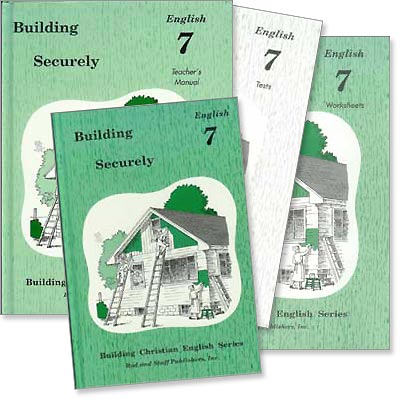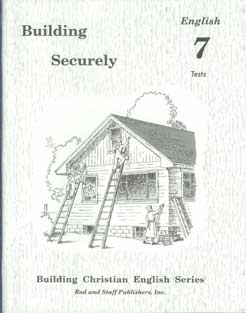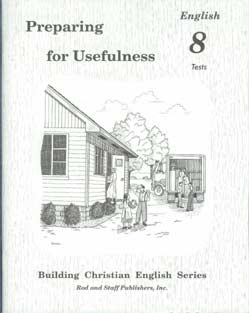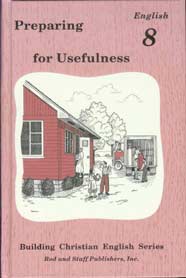.jpg)
Grade 8 English "Preparing for Usefulness" Set
- 5.704 lbs
Item #1-128--
| This set includes: | # in My Cart | ||
|---|---|---|---|
| Pupil Textbook | $24.60 | ||
| Worksheets | $4.95 | ||
| Tests | $3.95 | ||
| Teacher's Manual | $32.35 | ||
| This set includes: 4 items | |||
English 8 has 124 lessons divided into 11 chapters. The first two chapters deal with sentence elements and sentence structure. Objective complements, elliptical sentences, and compound-complex sentences are introduced.
Chapter 3 teaches concepts about capitalization and punctuation. Dashes, parentheses, and brackets are introduced.
Chapters 4-10 focus on the parts of speech. These chapters re-enforce what has been taught in earlier grades and introduce retained objects, dangling participles, and relative adverbs. Problem words are discussed, and there's plenty of sentence diagramming.
Chapter 11 deals with using reference helps and the public library. Composition lessons introduce persuasive arguments and teach effective sentences, paragraph construction, proofreading, outlines, story writing, sentences, paragraph construction, proofreading, outlines, story writing, and poetry at deeper levels. Over one-third of the book deals with composition.
A booklet of 42 worksheets offers extra practice. The sheets may be copied as needed in teaching this English course. The test booklet includes chapter tests and a final test.
Table of Contents
(Bold indicates Written Composition and Oral English lessons.)
Chapter 1 - Sentence Elements - Writing Letters
- 1. The Gift of Language
- 2. Writing Friendly Letters
- 3. Complete Sentences
- 4. Subjects and Predicates
- 5. Subjective Complements
- 6. Writing Business Letters
- 7. Object Complements
- 8. Objective Complements
- 9. Appositives and Independent Elements
- 10. Chapter 1 Review
Chapter 2 - Sentence Structure - Writing Paragraphs
- 11. Sentence Types and Word Order
- 12. Phrases and Clauses
- 13. Paragraph Unity and Topic Sentences
- 14. Simple and Compound Sentences
- 15. Complex Sentences
- 16. Compound-Complex Sentences
- 17. Sentence Styles
- 18. Achieving Paragraph Coherence
- 19. Transition Between Paragraphs
- 20. Chapter 2 Review
Chapter 3 - Mechanics - Developing Paragraphs
- 21. Capitalization
- 22. End Punctuation
- 23. Commas
- 24. Types of Compositions
- 25. More Comma Rules
- 26. Quotation Marks
- 27. Colons and Semicolons
- 28. Methods of Developing Paragraphs
- 29. Dashes, Parentheses, and Brackets
- 30. Italics (Underlining) and Numbers
- 31. Apostrophes and Hyphens
- 32. More Methods of Developing Paragraphs
- 33. Chapter 3 Review
Chapter 4 - Nouns - Using Outlines
- 34. Nouns and Substantives
- 35. Outlining
- 36. Plural Nouns
- 37. Possessive Nouns
- 38. Developing an Outline From a List of Notes
- 39. Using an Outline to Write a Composition
- 40. Verbals and Verbal Phrases Used as Nouns
- 41. Noun Clauses
- 42. Proofreading Your Composition
- 43. Chapter 4 Review
Chapter 5 - Verbs - Preparing and Giving Reports
- 44. Gathering Information About a Topic
- 45. Identifying Verbs
- 46. Principal Parts of Verbs
- 47. Organizing Your Notes
- 48. Simple Verb Tenses
- 49. Perfect Verb Tenses
- 50. Simple, Progressive, and Emphatic Forms of Verbs
- 51. Giving an Oral Report
- 52. Transitive Verbs
- 53. Intransitive Complete Verbs
- 54. Writing a Report From Your Notes
- 55. Intransitive Linking Verbs
- 56. Proofreading and Rewriting a Report
- 57. Chapter 5 Review
Chapter 6 - Verb Usage - Writing Stories
- 58. The Theme of a Story
- 59. Characterization in Story Writing
- 60. Subject-Verb Agreement
- 61. Using Problem Verbs
- 62. More Problem Verbs
- 63. Effective Style in a Story
- 64. The Opening of a Story
- 65. Writing a Story
- 66. Active and Passive Voice
- 67. Proofreading and Rewriting a Story
- 68. Chapter 6 Review
Chapter 7 - Pronouns - Writing Effective Sentences
- 69. Personal Pronouns
- 70. Using Personal Pronouns Correctly
- 71. Writing Effective Sentences: Unity and Coherence
- 72. Compound Personal Pronouns and Demonstrative Pronouns
- 73. Writing Effective Sentences: Conciseness and Parallelism
- 74. Indefinite Pronouns
- 75. Writing Effective Sentences: Action
- 76. Writing Effective Sentences: Emphasis
- 77. Interrogative and Relative Pronouns
- 78. Writing Effective Sentences: Variety
- 79. Chapter 7 Review
Chapter 8 - Adjectives - Studying Poetry
- 80. Recognizing Adjectives
- 81. Rhyme in Poetry
- 82. Rhythm in Poetry
- 83. Forms of Comparison for Adjectives
- 84. Verbals and Phrases Used as Adjectives
- 85. Repetition and Parallelism in Poetry
- 86. Descriptive Language in Poetry
- 87. Adjective Clauses
- 88. Using Adjectives Correctly
- 89. Writing Poetry
- 90. Appreciating Poetry
- 91. Chapter 8 Review
Chapter 9 - Adverbs - Writing Persuasive Argument
- 92. Recognizing Adverbs
- 93. Forms of Comparison for Adverbs
- 94. Verbals and Phrases Used as Adverbs
- 95. Taking Notes From a Sermon
- 96. Adverb Clauses
- 97. Distinguishing Between Adjectives and Adverbs
- 98. Using Adverbs Correctly
- 99. Understanding Persuasive Argument
- 100. Planning a Persuasive Argument
- 101. Writing a Persuasive Argument
- 102. Chapter 9 Review
Chapter 10 - Prepositions, Conjunctions, and Interjections - Writing Directions and Descriptions
- 103. Prepositions and Their Objects
- 104. Using Prepositions Correctly
- 105. Writing Directions to Place
- 106. Coordinating Conjunctions
- 107. Subordinating Conjunctions
- 108. Descriptive Writing
- 109. Interjections
- 110. Review of the Parts of Speech
- 111. Planning a Descriptive Composition
- 112. Writing a Descriptive Composition
- 113. Chapter 10 Review
Chapter 11 - Reference Sources - Giving Summaries and Book Reports
- 114. Using a Dictionary
- 115. Using a Thesaurus
- 116. Writing a Summary
- 117. Using Encyclopedias and Atlases
- 118. Using Concordances, Bible Dictionaries, and Topical Bibles
- 119. Using a Public Library
- 120. Using a Card Catalog
- 121. Give an Oral Book Report
- 122. Chapter 11 Review
- 123. Final Review 1
- 124. Final Review 2
Worksheets
Chapter 1
- 1. Subjective Complements (Lesson 5)
- 2. Object Complements (Lesson 7)
- 3. Objective Complements (Lesson 8)
- 4. Appositives and Independent Elements (Lesson 9)
Chapter 2
- 5. Paragraph Unity and Topic Sentences (Lesson 13)
- 6. Complex Sentences (Lesson 15)
- 7. Compound-Complex Sentences (Lesson 16)
- 8. Loose, Periodic, and Balanced Sentences (Lesson 17)
Chapter 3
- 9. Practice With Commas (Lesson 25)
- 10. Quotation Marks (Lesson 26)
- 11. Dashes, Parentheses, and Brackets (Lesson 29)
- 12. Italics, Numbers, Apostrophes, and Hyphens (Lesson 31)
Chapter 4
- 13. Verbals and Verbal Phrases Used as Nouns (Lesson 40)
- 14. Noun Clauses (Lesson 41)
- 15. Proofreading Your Composition (Lesson 42)
Chapter 5
- 16. Principal Parts of Verbs (Lesson 46)
- 17. Perfect Verb Tenses (Lesson 49)
- 18. Transitive Verbs (Lesson 52)
- 19. Intransitive Complete Verbs (Lesson 53)
- 20. Intransitive Linking Verbs (Lesson 55)
Chapter 6
- 21. Subject-Verb Agreement (Lesson 60)
- 22. Using Problem Verbs (Lesson 61)
- 23. More Problem Verbs (Lesson 62)
- 24. Active and Passive Voice (Lesson 66)
Chapter 7
- 25. Personal Pronouns (Lesson 69)
- 26. Using Personal Pronouns Correctly (Lesson 70)
- 27. Compound Personal Pronouns and Demonstrative Pronouns (Lesson 72)
- 28. Unity, Coherence, Conciseness, and Parallelism in Sentences (Lesson 73)
- 29. Indefinite Pronouns (Lesson 74)
- 30. Action and Emphasis in Sentences (Lesson 76)
- 31. Interrogative and Relative Pronouns (Lesson 77)
Chapter 8
- 32. Rhyme and Rhythm in Poetry (Lesson 82)
- 33. Verbals and Phrases Used as Adjectives (Lesson 84)
- 34. Adjective Clauses (Lesson 87)
Chapter 9
- 35. Verbals and Phrases Used as Adverbs (Lesson 94)
- 36. Adverb Clauses (Lesson 96)
- 37. Distinguishing Between Adjectives and Adverbs (Lesson 97)
- 38. Using Adverbs Correctly (Lesson 98)
Chapter 10
- 39. Prepositions and Their Objects (Lesson 103)
- 40. Using Prepositions Correctly (Lesson 104)
- 41. Coordinating Conjunctions (Lesson 106)
- 42. Review of the Parts of Speech (Lesson 110)









